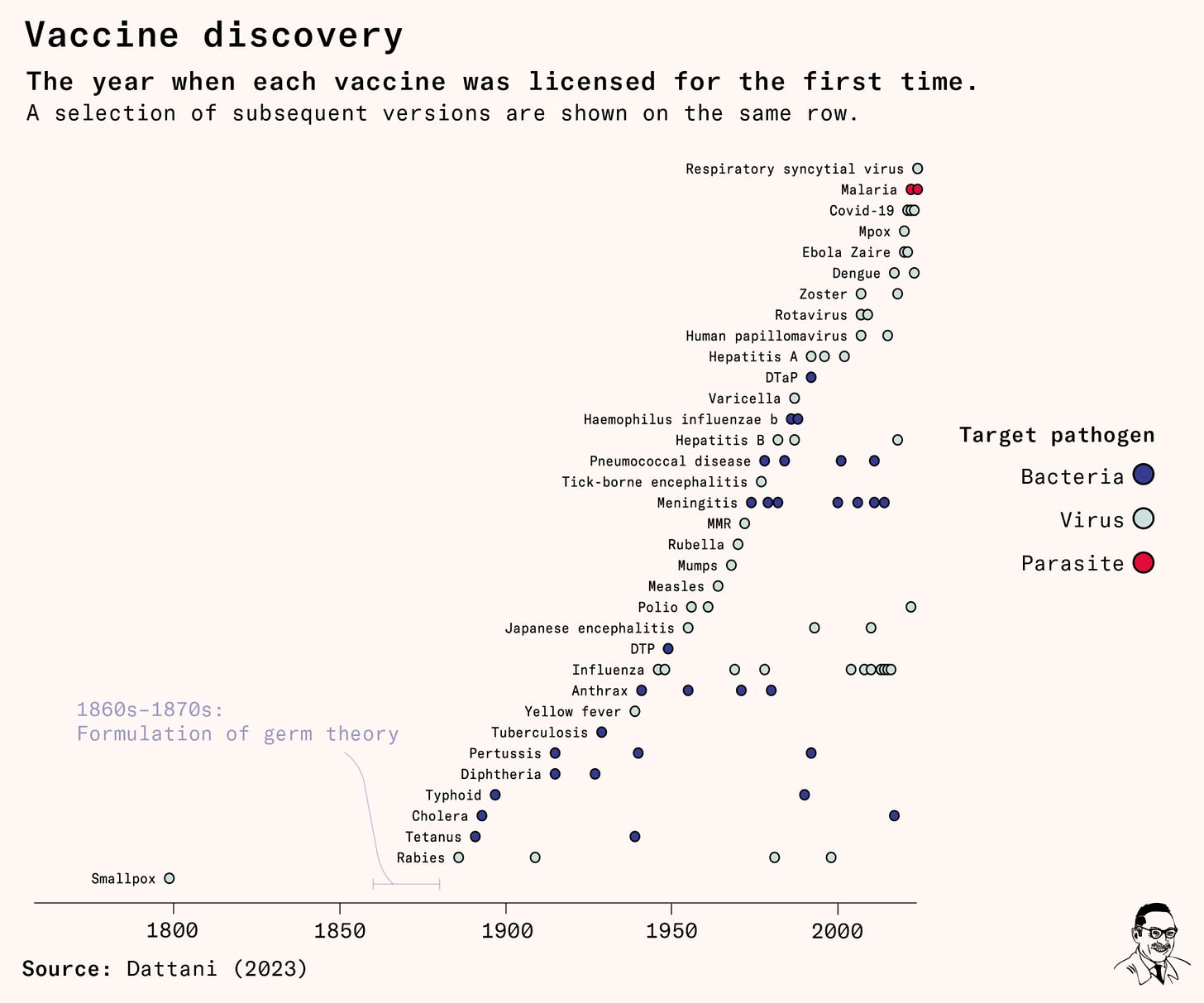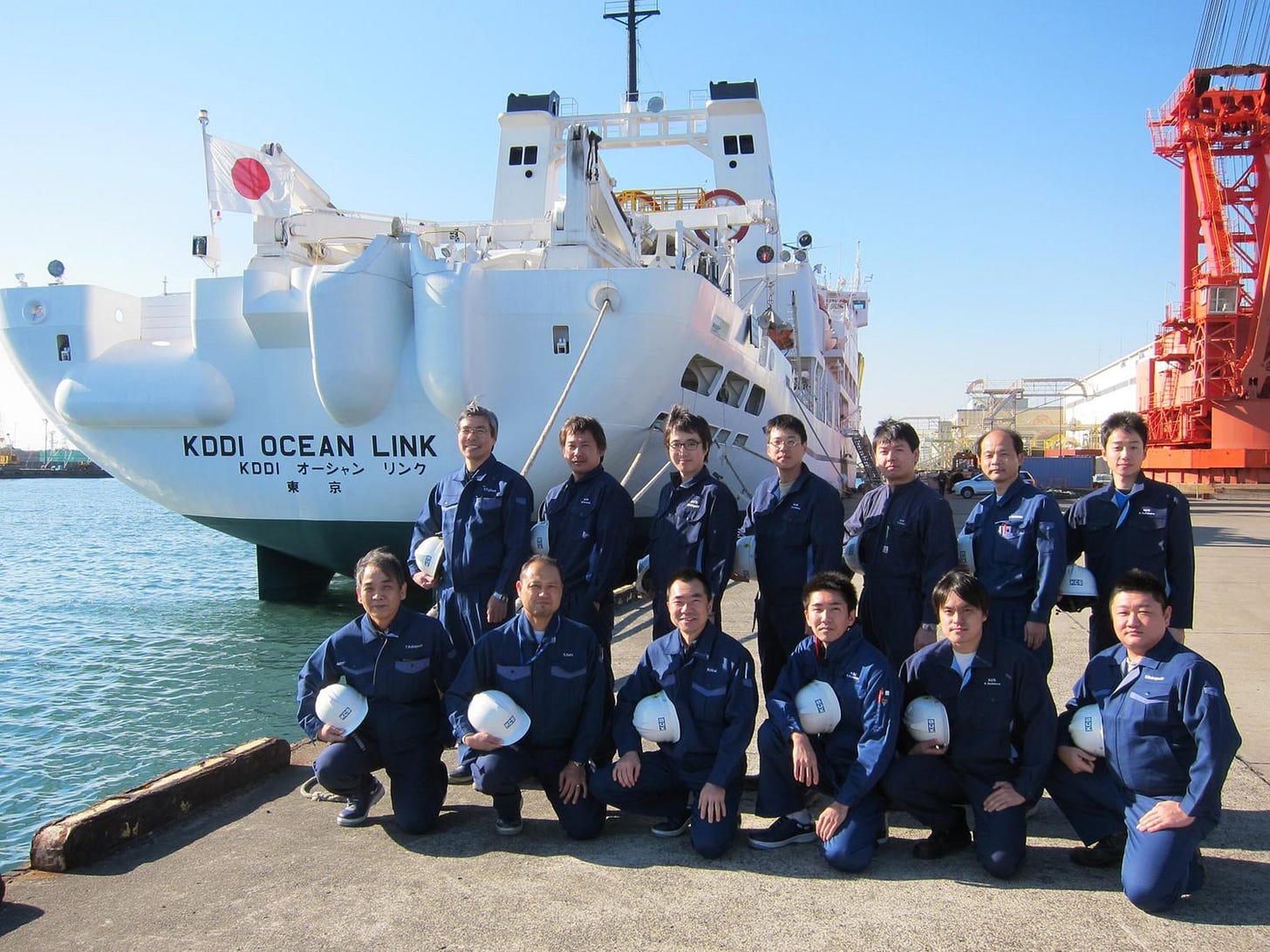Issue #17
Why we didn’t get a malaria vaccine sooner | The invisible seafaring industry that keeps the internet afloat | How do birds get their colors? | +4 Bonus Articles | Free Resources - Muted, Land Usage
Source: Salzkammergut, a Boat Trip on Lake Hallstättersee, Hallstatt in the Background by Anton Hlavacek
Est. Reading Time: 8 mins
Healthcare 🌡️
Why we didn’t get a malaria vaccine sooner
By Works in Progress
Annotations
Source: Works in Progress
Developing a vaccine for malaria is challenging for multiple reasons:
Finding a suitable animal model
Culturing the parasite in the lab
Identifying and refining the ingredients needed for a vaccine
To find a suitable animal model, researchers must identify an animal whose experience with the disease is similar to ours. This is crucial to understand how the pathogen infects us, causes disease, and how our immune system responds to it. The Plasmodium parasite which causes malaria has a complex life cycle making it highly adapted to each species. So, even if scientists had made a vaccine which protected the animals in the lab, it was possible that it wouldn’t have worked on humans.
Since a malaria vaccine was nowhere in sight and officials were aware that it was the female Anopheles mosquito that was the vector of malaria, they focused more on controlling mosquito populations.
Discovered in 1939 by Paul Müller and other scientists at the Swiss company Geigy, DDT was highly effective against a range of insects and its effects lasted for months. But as the popularity of DDT soared, cracks started to emerge- insects were developing resistance to DDT, including the Anopheles mosquitoes.
During the 1960s-1970s, there was a resurgence of interest in malaria research as the US entered the Vietnam War and wanted to protect its troops against drug-resistant malaria, and there were massive malarial outbreaks across South Asia and Turkey.
After multiple failed attempts across decades, researchers finally found a promising vaccine candidate - RTS,S vaccine.
In a 1997 human challenge trial, the RTS,S vaccine protected six out of seven of the volunteers, more effective than any of its predecessors.
By 2009, the vaccine was finally ready to enter phase III of the regulatory process, which involved more trials across several countries.
Six years later, phase III trials were finally complete and the results were positive. The vaccine reduced the risk of clinical malaria by 31% in children aged 6 to 12 weeks and 56% in those aged 5 to 17 months - but the protection declined after a year.
Finally, in 2021, after spending 23 years in 25 trials, the RTS,S vaccine was endorsed by the WHO for broad use in children.
As vaccines have to go through a rigorous approval process which takes 4 years on average and may not even see the light of the day as 94% of them fail to get approval, there’s little incentive for firms to go through the arduous journey. More so, the countries that are in dire need of the vaccine are incapable of buying the vaccines at the high prices quoted by the pharma companies.
To incentivize vaccine research, an innovative method of funding was developed - Advance Market Commitment (AMC). An AMC is an agreement involving three parties: sponsors, recipient countries, and pharma firms. Sponsors commit to subsidizing vaccines that meet specific eligibility criteria, up to a predetermined dose limit. For instance, a global fund might cover $14 out of $15 for the initial 200 million doses of vaccines with an efficacy exceeding 70%. In turn, the countries receiving the vaccines agree to pay the remaining portion of the cost ($1 in the given example).
In return, the pharma companies commit to provide further doses at a low price, close to the cost of production. In the given scenario, pharma companies that create eligible vaccines would initially benefit from the $15 price for the first 200 million doses. However, they would subsequently need to offer all additional doses (over and above the 200 million) at a reduced price, such as $1 per dose. This condition ensures long-term affordability for the developing countries.
Technology 🚢
The invisible seafaring industry that keeps the internet afloat
By The Verge
Source: The Verge
Annotations
The world’s internet is carried through 800,000 miles of cables as thin as a garden hose crisscrossing the Earth’s oceans. With multiple new transoceanic lines announced every year, the world is in the midst of a cable boom. The industry had its watershed moment in 2016 when tech companies seeking to cater to the growing content needs of their users began investing in their own cable systems instead of purchasing bandwidth from telecom firms.
If there are cables, there will be cable breaks. Cable breaks happen around 200 times a year or almost every alternate day. Humans continue to be the greatest threat to cables, with fishing causing about 40% of faults, according to the International Cable Protection Committee (ICPC).
Despite the frequent cable breaks, videos continue to load, and digital payments continue to function because of the thousand or so people living aboard some 20 ships stationed across the world, who race to fix each cable as soon as it breaks.
Cable repair continues to be an analogue process despite being the bedrock of the digital age. In short, a broken cable is fixed by patching the break with a piece of new cable. Cable repair is usually composed of the following steps:
The ship cuts the cable near the break
The ship holds one end of the severed cable, hoists it to the surface, and attaches it to a buoy
Then the team gets a hold of the other cable end, splices the spare cable to it, and tows the spare cable back to the first buoyed cable to complete the patch
With a growing number of cables being laid, the number of ships in charge of maintaining these cables has not grown commensurately. According to Subtel Forum, there are 77 cable ships in the world with only 22 of these designated for repair while the rest are focused on the more profitable work of laying new systems. The cable repair ships are usually converted tug boats or ferries.
The industry is currently facing a worker shortage, due to the inconspicuous nature of the industry, and the nature of the work which demands extensive on-the-job training. Generally, people in this field come from merchant navies, marine construction, cable engineering, geology, optics, or other tangentially related disciplines.
Recently, geopolitics was added to the list of challenges faced by the industry. Tensions in the South China Sea, conflicts in the Middle East threatening the Red Sea, and the 2022 Nord Stream pipeline explosion have forced governments to take a closer look at cable security. India, the EU, and other governments have proposed investing in maintenance vessels directly.
Nature 🦚
How do birds get their colors? A guide to your vibrantly hued, winged friends
By USA Today
Annotations
Understanding bird colouration requires biology and physics. Birds primarily get their colour through pigmentation and the physical structure of the feather.
Pigments are chemical compounds found in animal and plant cells. They give colour to these organisms and can absorb or reflect specific wavelengths of light. Birds obtain certain pigments, like carotenoids, which are responsible for the vibrant reds, yellows, and oranges observed in birds, by consuming fruits, seeds, or insects. Carotenoids are the same pigments that give carrots and pumpkins their distinctive colours.
Another way birds achieve their appearance is through structural colours. These colours arise from the interaction of light with microscopic feather structures. Within the feathers, small air bubbles refract and scatter light, resulting in the vibrant colours we observe.
The colours that birds possess ultimately comes down to evolutionary trade-offs and selective pressures. The strongest pressure is what leads to the bird’s feathers being in a certain way, whether it’s to impress a mate, blend into the environment, or stay cool in a hot place. While bright colours aid in social and sexual signalling, they can attract predators.
As bright pops of colour tend to be signalling colours for social interactions, they often appear on a bird’s crown, throat, or breast – areas that face other birds while the bird’s back is usually darker which aids in camouflage. This adaptation is known as counter-shading, which helps the bird blend in and avoid drawing attention to itself. Birds such as the male ruby-crowned kinglet, can flash a scarlet-red crown when excited or keep it hidden when needed.
Source: USA Today
Molting is the process where the birds shed their old feathers and grow new ones, which can result in colour transformations. Many birds undergo an annual molt, usually after the breeding season. However, species like American goldfinches replace their feathers twice a year. Molting serves to maintain optimal feather conditions for flight, allowing birds to replace worn-out feathers and rid themselves of parasites.
Bonus 🎁
Read the room by Effect & Affect
Source: Effect & Affect
A crisp and informative article about “ensemble perception”.
Fake Views – The Contrast Between Renderings and Reality by The Architectural Uprising
The next time you see the rendering of a proposed building, you’ll be skeptical.
What The Last of Us, Snowpiercer and 'climate fiction' get wrong by the BBC
A must read article about how climate fiction has led to doomerism instead of galvanizing support for positive climate action.
India’s electric rickshaws are leaving EVs in the dust by Rest of World
An interesting article about the emerging industry of EV rickshaws in India.
Free Resources 💡
Muted: A collection of interactive music theory tools & visual references to learn music online for free.
Esri | Sentinel-2 Land Cover Explorer: Explore the changes in global land usage patterns between 2017 and 2023 using this interactive map.
For more free resources (190+ websites and tools), check out Searching.











